Life has existed on the planet for nearly 3 and a half billion years now, counting from the emergence of the simplest single-celled organisms not long after the planet cooled off enough for the oceans to form to the time I’m writing this (and hopefully whenever you’re reading this). With this much history to life on our planet, it makes a lot of sense that people tend to mush it all into a big blurry ball of Flintstones time, when every prehistoric animal lived alongside one another. Even major movies tend to compress time in this way; in Jurassic World Dominion’s prologue we see a Giganotosaurus and a Tyrannosaurus fight in the Cretaceous, despite them living several million years and thousands of miles apart.
Thankfully, geology provides labels for every period of time since earth solidified out of space dust. To keep things somewhat simpler, we are only looking at what is called the Phanerozoic Eon. Phanerozoic is Greek for “visible life”, and refers to the fact that this is when multicellular life took off. It’s a little more complex than that, but that will do for a basic guide. Each time period has infinitely more going on than I could possibly cover, but this should give you a good idea as to the major developments in each. This article is about the first era of the Phanerozoic, the Paleozoic, or the time of ancient life.
The Paleozoic
Cambrian
The Phanerozoic Eon begins 539 million years ago with the start of the Cambrian period. As established before, life had existed for 3 billion years at this point, but almost entirely in the form of microscopic, single-celled organisms. The end of the Precambrian (a general term for everything before the Phanerozoic, counting from when the earth formed) saw the rise of the first life forms that we could see as individuals with no magnification, the bizarre Ediacaran Fauna. These seemed to be extremely early animals, several apparently from entire groups that have no living members. For the most part, this strange wave of life died out at the very end of the Precambrian, killed off by a brief ice age and making way for the still alien but overall more familiar life of the Cambrian.
The Cambrian is best known for the “Cambrian explosion”, the relatively sudden appearance of an incredible diversity of life, with many forms recognizable as representatives of modern groups still with us. In fact, every modern phylum except one has some early members who first appear in the Cambrian, including our own. Phyla are the broadest group of life under kingdoms (animalia as a whole is a kingdom), and our phylum is Chordata, named after the notochord, a line of tissue that passes through the entire body and in vertebrates forms into the backbone. The first chordates of the Cambrian didn’t have backbones yet, or any bones for that matter, and most resembled lancelets.
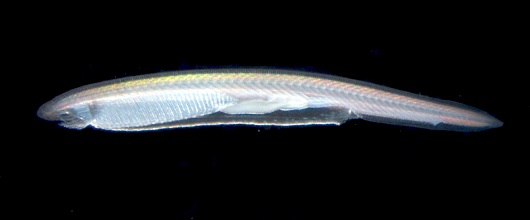
A lancelet, a modern non-vertebrate chordate. The segmented band down the back of the animal is the notochord. Lancelets bury themselves in the sea floor, tail first, and filter out passing microbes. Credit: University of St. Andrews
While the overall forms that these animals took may look strange to the modern eye, the Cambrian was actually the beginning of many of the familiar aspects of modern life. Eyes evolved multiple times, a massive boon for both finding food and avoiding becoming food. For similar reasons, animals with hard parts became common, from the exoskeletons of arthropods to shells for mollusks and bivalves. These protected against the new active predators like Anamalocaris, a close relative to arthropods that used its two strange mouthparts to grab prey. Anamalocaris and its relatives, known as radiodonts, were members of Panarthropoda, a clade that includes arthropods as well as tardigrades (the famous water bears) and velvet worms, either of which could be the closest modern relatives of the most ferocious predator of the Cambrian.
In general, the Cambrian was a time of extreme experimentation in arthropods and their cousins, with some modern groups like crustaceans evolving by the end. The very end of the Cambrian even saw some arthropods making the first brief emergences onto land, foraging on beaches and tidal flats like modern crabs. However, for the true start of life on land, we need to look at the next time period.
Ordovician
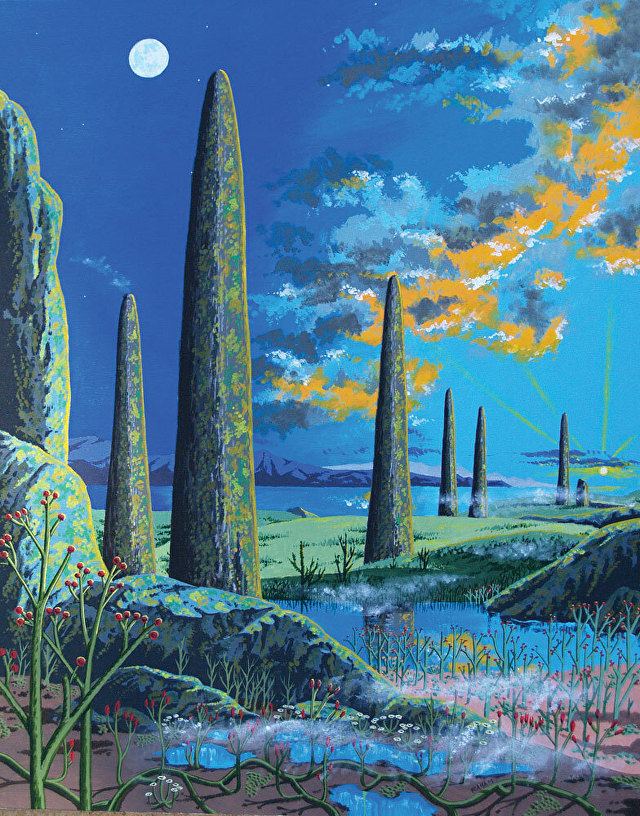
Prototaxities as drawn by Gary Raham
The Ordovician sees our final animal phylum join the roster, the bizarre Bryozoa or “moss animals”, sedentary creatures that grow multiple copies of their body to cover surfaces underwater. They became a large part of the impressive reef environments that thrived in the extensive shallow seas of the early Paleozoic. Speaking of moss, the first plants spread to land during this period, and the earliest would have been most similar to moss. The complex vascular system that let plants grow taller had not yet evolved and would not for a long time to come. With no trees, the largest living beings on land were enormous fungi, simple rod-like towers up to 25 feet tall. These surreal spires were like skyscrapers sticking out of carpets of ground-hugging plant life. And underfoot, crawling through these flat forests, may have been the very first terrestrial animals; tiny, burrowing millipedes.
Life in the oceans continued to thrive and diversify. Orthocone cephalopods, resembling modern nautiluses but with extremely long, conical shells, took off in diversity. The largest orthocones were titans for the time, some of them over 25 feet in length. On our own evolutionary path, vertebrates were diversifying as well. The very first armored fish developed during the middle and late Ordovician, coated in plates of hard enamel, derived from the teeth earlier fish had. Notably, these were still jawless animals, their ancestors more like lampreys or hagfish. One branch would develop jaws and become the more famous placoderm line, but that only happened at the very end of the Orodovician and their members are more famous in the next two periods up.
A third major development of the Ordovician was the development of the famous sea scorpions, more accurately known as the Euripterids. Their common name comes from the stingers on their tails, which were possibly venomous in some species, and the pincers that grew from the faces of most of the group. Some were strikingly large; the biggest didn’t come along until later, but Pentecopterus was still longer than an average man is tall. They were also a diverse group. The majority were swimmers, using their paddles to propel themselves like a modern crab, or even “flying” underwater like sea lions. However, they did have legs, and one branch, the stylonurina, completely forewent their paddles in favor of stronger limbs for walking on the sea floor. Sea scorpions started in the oceans, but eventually found their way into freshwater ecosystems, and some even climbed onto land and breathed air, but that is a tale for later.
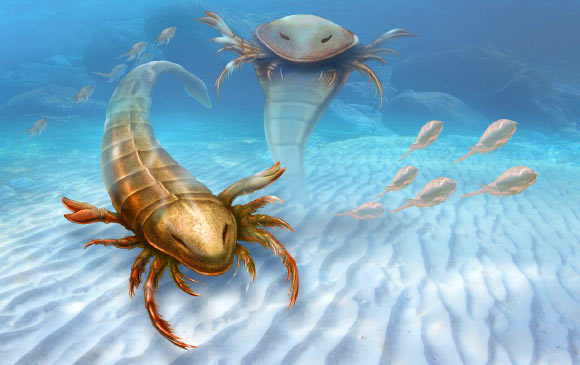
Pentecopterus by Patrick Lynch
The end of the Ordovician saw one of the world’s great mass extinctions, where a majority of species die off in a geographically short period of time. The Ordovician’s was the second-worst, with 85% of marine species going extinct. This largely consisted of two phases. In the first, a brief yet intense glaciation both chilled the waves and lowered sea levels by over 300 feet. Many of the shallow reefs of the world were left high and dry. In the second phase, the sea level just as suddenly rose and oxygen levels dropped, killing those in middle-depth and deeper waters. The Silurian was starting off with something like a clean slate.
Silurian
The land was less impacted by the sea level changes that devastated the oceans, already populated mostly by hardy generalists. Most of the major changes to land life are known from towards the end of the Silurian. Fungal spires continued to be the largest living beings on land, but plants were becoming more diverse, with the very first vascular plants emerging. The vascular system in a plant is similar to an animal’s circulatory system, delivering nutrients through the body. This enabled plants to grow larger, and in particular taller. The first plants with stems emerged, some like Baragwanthia using their new height to catch more sunlight and outcompete their ground-hugging rivals, and others like Cooksonia placing their spore pods atop twiggy branches to spread their children far and wide.
Under these new tiny trees, we now not only see the millipedes who made it to dry land first but their first confirmed predators; arachnids! These first hunters were not spiders or any other modern group of arachnid, but they were the first known animals with the “book lungs” that modern arachnids breathe air with. Known as the Trionotarbida, these tiny predators most closely resembled the modern hooded tickspiders, a rare branch of arachnid that looks somewhere in between a mite and a spider, and may have even been their ancestors (or at least closest relatives).
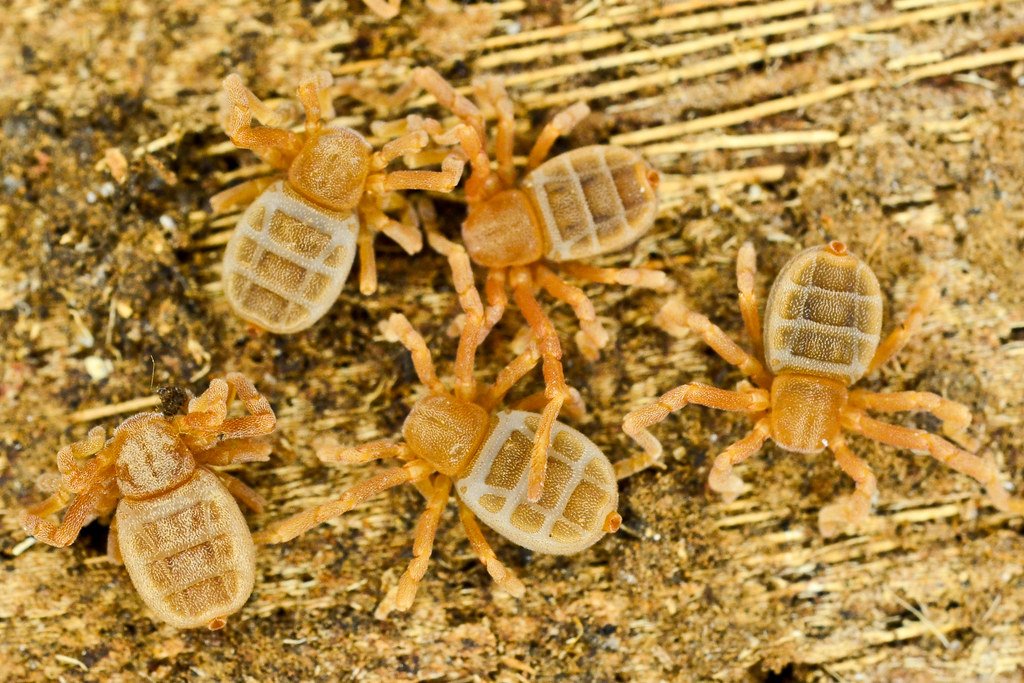
A group of tickspiders, very similar to trinotarbids. Photo taken by Leonardo Carvalho
In the oceans, we once again find vertebrates up to something unusual. Up till now, the only animals with anything we could call jaws were invertebrates, but now our ancestors were catching up. It was a process with many steps, starting with merely more ability to open and close the mouth and ending in fully-mobile jaws, complete with teeth. With the development of such useful tools, vertebrates see a new explosion of diversity. From placoderms, both modern bony fish and fish with skeletons of cartilage independently evolved, losing their armor plating in the first case and both their armor and bony skeletons in the second. This explosion of diversity would carry on into the next period of life, often called the Age of Fishes.
Devonian
While jawed fish appeared in the Silurian, it was during the Devonian that they diversified. Both bony and cartilaginous fish produced many predatory forms, but they were all outsized by Dunkleosteus, a genus of placoderm with some species reaching nearly 30 feet in length. Nearly equal in size was Titanichthys, which filled a whale-like role, using its mouth plates like baleen to trap tiny prey. Other placoderms were ambush predators, like the freshwater Phyllolepis. With a flattened body and reduced eyes, they likely hid in murky water and took prey who passed above by surprise.
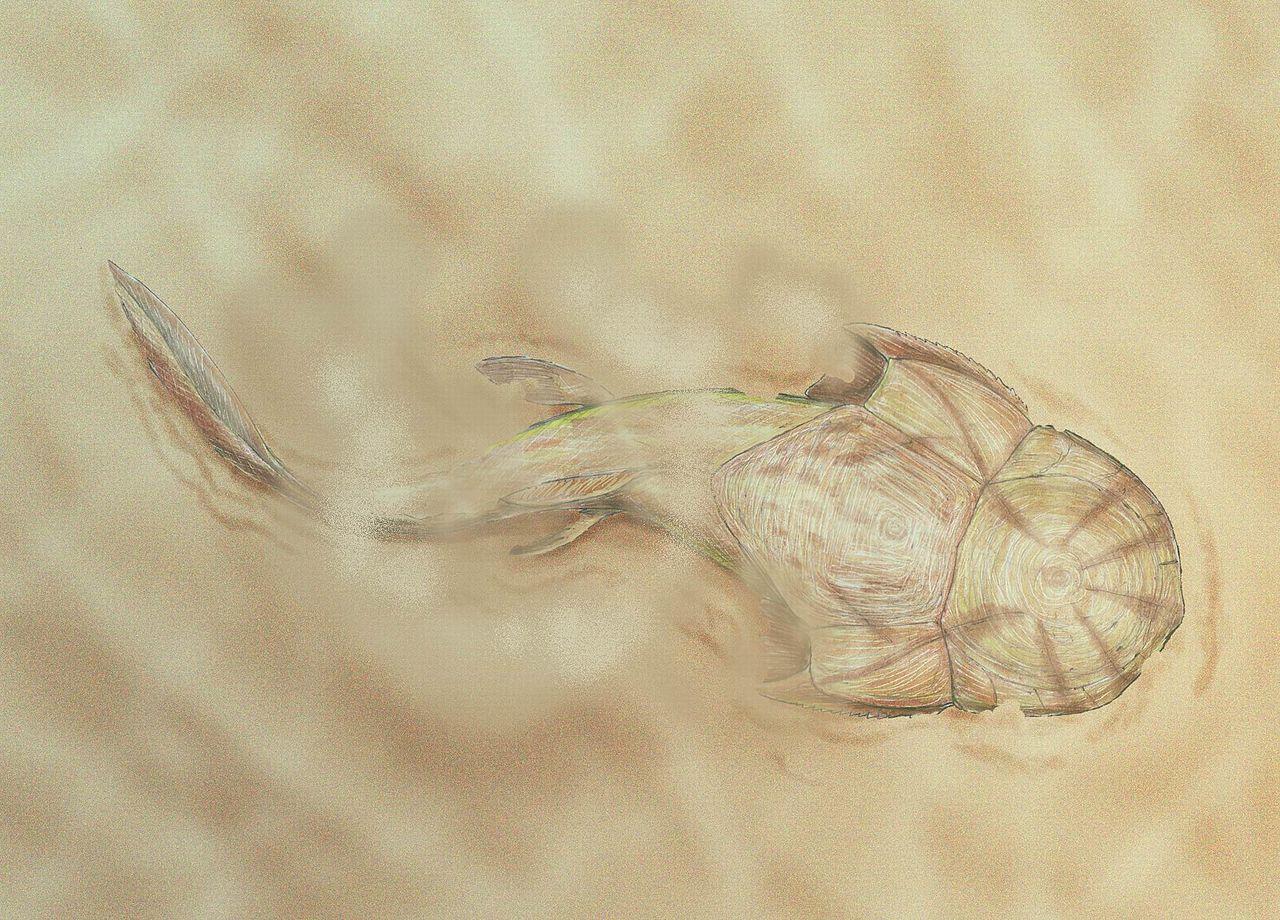
Phyllolepis partially buried on the river bottom. By Dmitry Bogdanov – dmitrchel@mail.ru, CC BY 3.0, https://commons.wikimedia.org/w/index.php?curid=3544291
Around the rivers and lakes, the only glimpse vertebrates had yet of land, the world was going green. The very first trees had evolved by the middle of the period, odd-looking things like a palm tree topped with a fern. They quickly began to spread to the more humid parts of the planet, making Earth’s first forests. Places not suitable for trees were host to plains of the new vascular plants, like ferns and club mosses, joined later on by the first seed-bearing plants. In this new garden, arthropods continued to thrive and diversify. Uraraneida was a new group of arachnids, ancestral to spiders. The most famous member of the group, Attercopus, resembled a modern spider for the most part, but also had a “tail” similar to a modern whip scorpion’s. Attercopus had the ability to produce silk, but did not yet have a spider’s full spinnerets for laying it down with precision. It and its relatives likely hunted for their prey instead of making webs to trap them, much like many arachnids do today.
Insects potentially also evolved in this period, although the fragmentary remains we have to go on are hard to interpret. One contestant for the oldest insect is the Early Devonian Leverhulnia, which was primitive enough that it’s difficult to tell if it was an early insect or merely a very close relative. If an insect, it would have been wingless and not undergone metamorphosis, resembling a modern silverfish or bristletail. Another possible early insect is Rhyniognatha hirsti. The only known remains are a mess, with only the head being in any condition to interpret. Early studies suggested, based on the structure of its mandibles, that it might have been a mayfly, in other words a flying insect, something otherwise thought to have evolved in the Carboniferous. If this was the case, then flight evolved for the first time in the Devonian. However, more recently it has been suggested that Rhyniognatha was instead a centipede, which puts the first flying insects a little closer to home.
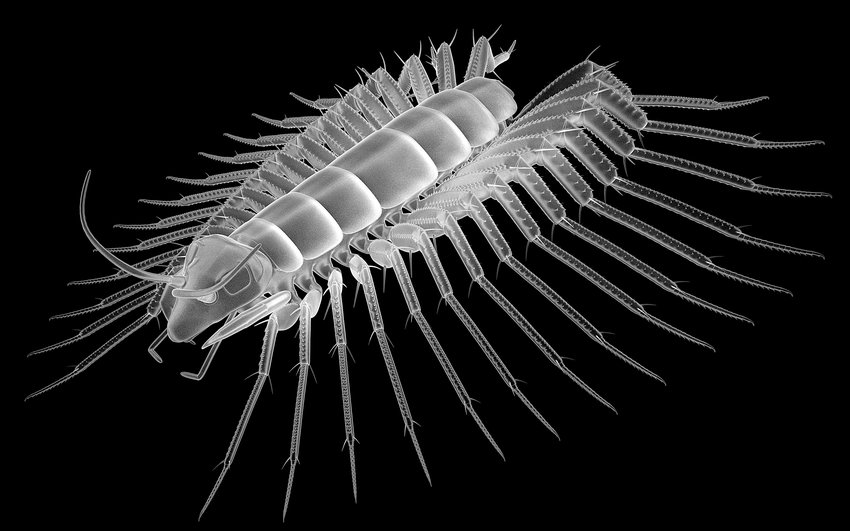
A speculative reconstruction of Rhyniognatha as a centipede. Credit: Carolin and Joachim Haug
And on the very edges of this newly greened world, the Age of Fish continued. In the Silurian, bony fish had split into two major branches. The actinopterygians, or ray-finned fish, and the sarcopterygians, or lobe-finned fish. Ray-finned fish are the majority these days. Goldfish, tuna, salmon, anglerfish, almost every living fish is ray-finned. Lobe-finned fish have fins with a structure more like our own limbs, with a bone joining the fins to the main body in a fleshy stalk. There’s a reason that limb structure sounds a lot like ours; we, like all tetrapods, are lobe-finned fish. Tetrapoda is the clade of animals that descended from those original four-limbed vertebrates. In cladistics, your ancestry sticks with you, which is why tetrapods are still sarcopterygians, and animals that secondarily lost some or all of their limbs are still tetrapods.
The transition was long and winding, and it’s important to remember that these species weren’t just ladder rungs with the inevitable result of us fully terrestrial tetrapods; indeed, many animals that still straddle the line between terrestrial and aquatic life still thrive today. A good example is Tiktaalik, one of many close relatives to the tetrapod line. Tiktaalik is basically the perfect transitional species. It had scales, gills, and fins instead of legs. Then on the other hand, it had a neck, possibly lungs, and its fins had wrists. Wrists aren’t really important underwater, but the ability to adjust your limbs that way on land is incredibly useful. Compare the flexibility of a sea lion’s flippers to those of a whale and you get a good idea of how helpful this would be. However, evidence shows that more “advanced” tetrapods already existed at the same time as Tiktaalik, making it a bit of a throwback. The adaptations continued to be useful in the shallow, often oxygen-poor streams that Tiktaalik frequented, letting them leave the water when necessary. By the next period, these adaptations had taken vertebrates onto the land.
Carboniferous
The Devonian ended with another of the “Big Five” mass extinctions. The reasons are obscure, ranging from another bout of climactic instability to a distant supernova damaging the ozone layer. Whatever the cause, we once again see a turnover in common fauna. The placoderms were gone, leaving opportunities for other vertebrates to take their roles. True sharks had not yet evolved, but their equivalent role was filled by the hybodonts, who looked similar to modern sharks but with spines on their fins and horns on the heads of males.
With the recent greening of the world and a warm, humid climate over much of the continent Euramerica, rainforests of a size that would put the Amazon to shame covered much of the land. Rivers, lakes, wetlands and sodden forests were the perfect environments for an incredible diversification of lobe-finned fish, including the brand new tetrapods. I wouldn’t recommend swimming in these rivers. The very largest freshwater fish of our day is the Arapaima, maxing out at about 8 and a half feet long. In the Carboniferous, there was instead Rhizodus hibberti, a 23 foot long lobe-finned fish that could possibly even heave itself onto shore to catch terrestrial animals who got too close like a modern orca does.

A Rhizodus patrolling the river. Credit: Dr. M. I. Coates
For most of the Carboniferous, the land continued to be dominated by arthropods. The millipedes may no longer have been the only land animals, but they still had life in them; Arthropleura was the largest arthropod to ever walk the land, the largest over 8 feet long. For most of the period, they were the biggest things on land and likely effectively invulnerable when fully grown. This was also the period where insects went from just another group of bugs to the most dominant group of terrestrial animals with the evolution of flight. This was the very first time anything had taken to the sky, and it opened up an entire range of niches no other animal could fill. This included aerial predators like the Meganisoptera, or “griffinflies”. Similar to modern dragonflies, they likely caught other insects on the wing. Unlike modern dragonflies, the largest, like Meganeura moyni, having wingspans of over 28 inches. That’s less “large insect” than “mid-sized songbird”.
The sea scorpions, on the other hand, were not thriving. The end-Devonian extinction killed off nearly the entire order, leaving only freshwater stylonurians and a single swimming species. However, what was possibly the largest ever sea scorpion evolved at this time, and even walked onto land from time to time. This was Hibbertopterus, a heavily-built creature shaped something like a horseshoe crab (whose ancestors also existed at the time and looked quite similar to the modern species) but vastly larger, at least 4 feet long but potentially up to 8. Hibbertopterus and its relatives were what we call sweep-feeders, running their spiny legs through silt to pick up small animals.
In and around the water, the early tetrapods were undergoing their own intense period of diversification. Early in the era, we see basic, very fish-like animals, with big heads, finned tails, and 6 or more fingers, rather than the maximum of five later land animals would have. A good example of this body type is Pederpes finneyae, which had sturdy limbs and forward-facing feet, likely allowing it to be more terrestrial than earlier animals like Tiktaalik. Later, we have an incredible array of wildly different animals, from the tiny salamander-like microsaurs to snake-like aistopods and adelospondyls, who completely dropped the idea of legs right after evolving them. Some of these were amphibious, while others returned entirely to the water, and several groups were leaving the water behind entirely, with a final adaptation creating a new branch of life.
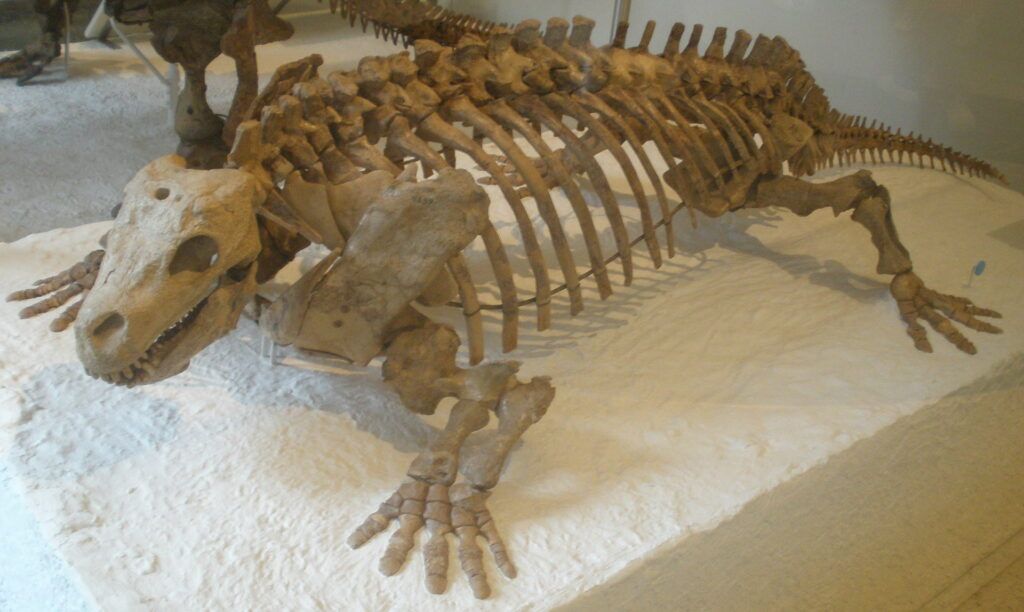
Diadectes sideropelicus skeleton at the American Museum of Natural History. Note the extremely robust limbs and obvious parietal eye. Photo by Ghedoghedo
By the middle of the Carboniferous, several groups of tetrapods were in essence entirely terrestrial. They had no adaptations for swimming, instead walking with sturdy legs on land. Some were large, heavy herbivores that outmassed even Arthropleura. Others were tiny, scurrying things that looked like salamanders or lizards. Unlike modern amphibians, they may have had dry skin or even scales, but like amphibians, they still had to return to the water to lay their eggs. This was solved with the evolution of the amnion, a membrane that sealed moisture within the egg so that it did not need to be kept constantly wet. This, combined with a few other adaptations for terrestrial egg-laying, let the new “amniotes” leave the water behind entirely. From then all the way till now, the largest animals on land and in the sea would be amniotes.
Before the end of the period, amniotes had split into two branches; the synapsids and the sauropsids. Sauropsids include everything you think of as a “reptile” and also birds, although none of the branches we are familiar with would emerge until much later. Synapsids were extremely diverse through the rest of the Paleozoic, but by the end of the Triassic, their only remnants were mammals (probably, we’ll discuss this when we get to the Cretaceous). They even produced some of the earliest truly massive land vertebrates, the caseids.
Permian
By the start of the Carboniferous, all the world’s continents had drifted together into the massive supercontinent known as pangaea. By the end, much of the interior of the continent was drying out, leaving more arid climates by the middle of the Permian. Thankfully, the amniotes were well-suited for a cooler, drier world, although remaining rainforests in modern-day China supported life more similar to that of the Carboniferous. More basal tetrapods continued to thrive in amphibious and aquatic roles, such as the enormous Prionosuchus, a gharial-like animal that likely preyed upon both fish and unlucky land animals who got too close.
While sauropsids were diverse from their origin, the Permian’s megafauna niches largely belonged to the synapsids. Early on, most of these were “pelycosaurs”, an outdated term for “primitive”, reptile-like synapsids. These are what were also commonly called “mammal-like reptiles”, another term that is considered outdated, as they were not reptiles at all. Of these, the most famous was Dimetrodon, which has unfortunately had a long time being either lumped in with dinosaurs or called a primitive failure of evolution.
It was neither of these, instead being an extremely successful genus that lasted 25 million years with multiple species, many of them likely apex predators in their environment. Their prey would include the similarly-sailed Edaphosaurs, small reptiles, and even the local amphibious animals, like the boomerang-headed Diplocaulus, which they apparently dug out of the ground when they were hiding from the dry season. These species were incredibly diverse as well, with the largest being the 15 foot D. angelensis, versus the cat-sized D. teutonis, which lived among other apex predators like Sphenacodon. Dimetrodon seems mostly to have been an animal of the lowlands, lurking around rivers and wetlands.
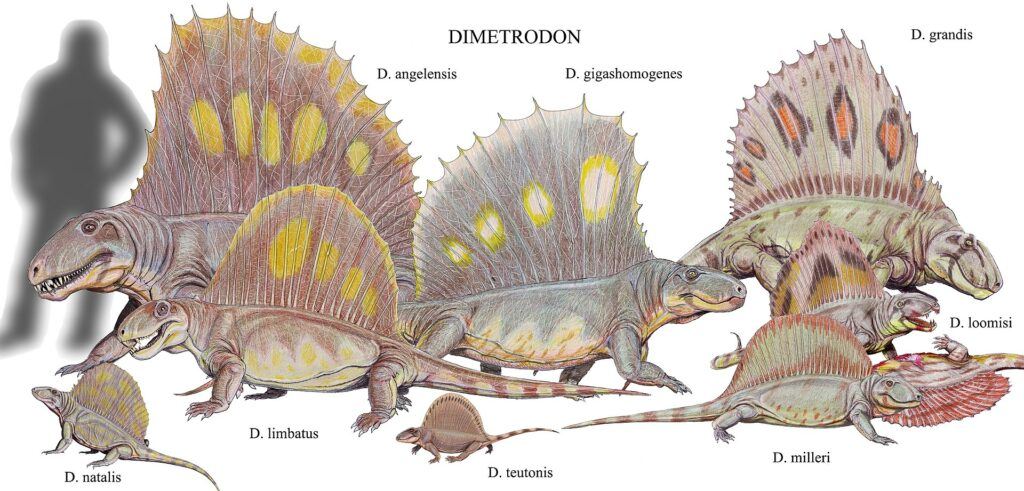
Dimetrodon species. I want a D. teutonis. Creator unknown, Creative Commons License
The only tetrapods larger than Dimetrodon at this period were the caseids, animals with enormous, barrel-shaped bodies and tiny, potato-shaped heads. They had spongy bones that may have been poor at supporting their weight and so may have been restricted to the water, acting like 20-foot long hippos, but might have also used their wide, clawed feet for digging up tasty roots and tubers. Smaller herbivorous and omnivorous roles largely belonged to smaller Edaphosaurs and reptiles like the Captorhinidae, lizard-like animals with massive heads.
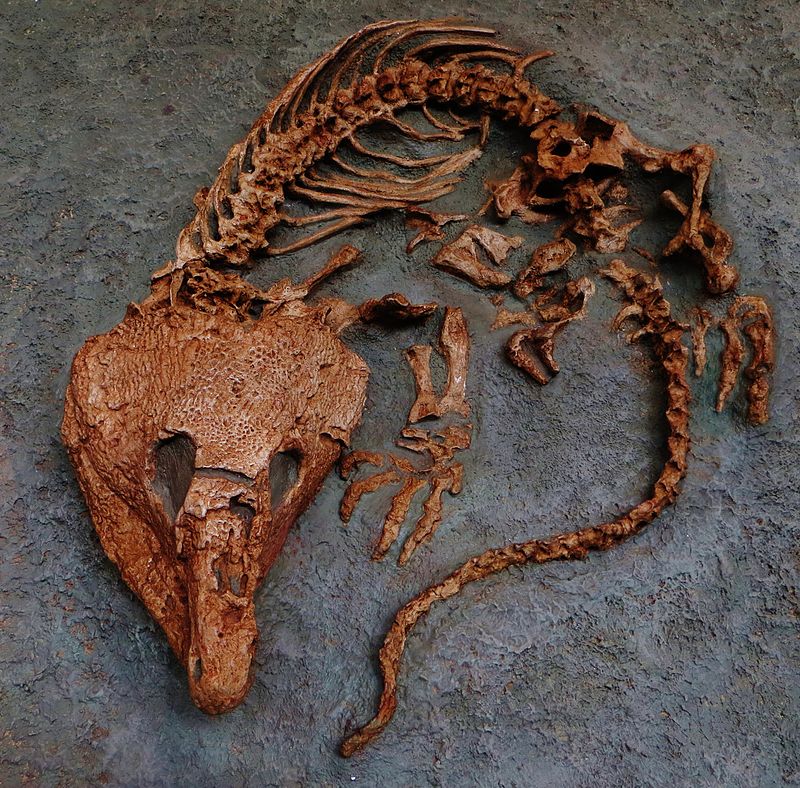
Labidosaurus hamatus, a possibly omnivorous Captorhynid. Photo by Ghedoghedo, Creative Commons License
At this same time, sauropsids were making an unusual venture of their own; returning to the water for the first time. Both branches of amniota would make a habit of this, but the Mesosaurs are the first animals who definitely did so. They had long skulls full of needle-like teeth, a paddle-like tail, and webbed feet. Later marine reptiles would become truly massive, but it seems that Mesosaurs never got much bigger than a meter and mostly ate small crustaceans. It’s also unclear exactly how aquatic they were, and whether they spent any time on land at all, but it’s interesting to see this diversity so early on.
273 million years ago, around the middle of the Permian, there was a mass extinction known as Olson’s Extinction. While not as massive as the ones that followed, it did clearly reshape the landscape of the Permian. Land and sea, plant and animal, all life suffered the effects, but the most noticeable effect from our perspective is the overhaul in megafauna. The pelycosaurs were gone, and in their place, a new branch of synapsids known as the therapsids. They had emerged from within Dimetrodon‘s own family, the Sphenacodontia, and overall weren’t too different from their ancestors at first, but quickly their diversity exploded.
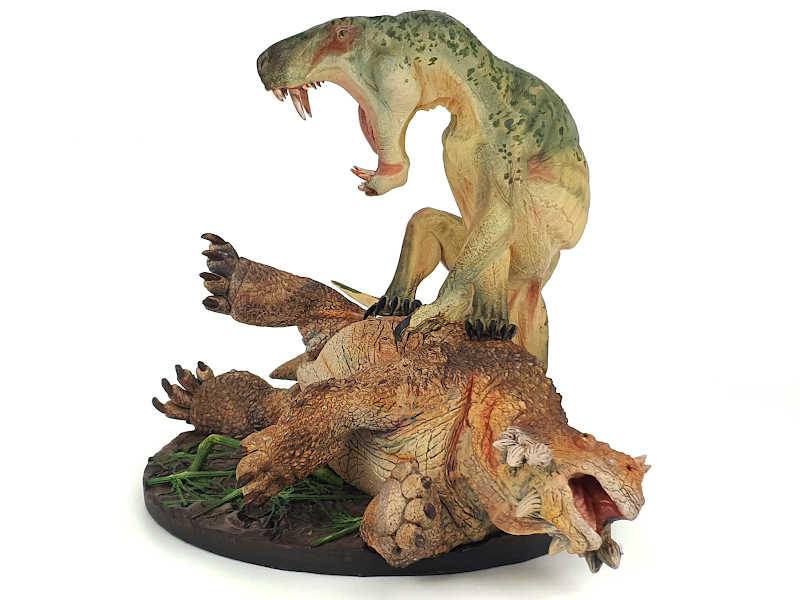
The animal on top is Inostrancevia, one of the largest therapsid predators of the Permian. Its prey is a Scutosaurus, which wasn’t a synapsid but one of the largest reptiles of the time. Model by Vitali Klatt
To capture some of the incredible diversity of the therapsids, let’s just look at one branch, the Dinocephalia. Many of them had large, extra-bony skulls, often decorated with bosses or horns. This group produced large carnivores and herbivores alike, such as the bizarre Estemmenosuchus. This squat, vaguely hippo-shaped omnivore had four broad, flat horns sticking from the top and sides of its head, their squashed shapes something like moose antlers. While their odd skulls are what most people would notice, they are also one of the few non-mammalian synapsids ever found with fossilized skin impressions. The small patch found didn’t have signs of hair or scales, basically being most similar to bare mammalian skin. It is unknown if it might have had scutes on its belly like Dimetrodon, or how similar the skin of other therapsids was.
Unfortunately for the therapsids, and everything else that had the misfortune of being alive at the time, we are now reaching the end of the Permian. The final era of the Paleozoic was marked by the greatest mass extinction of all time, often called “The Great Dying”. Much of what is modern day Russia became an ocean of magma as volcanic activity skyrocketed. The methane and carbon dioxide released caused temperatures to spike, while also acidifying the oceans. Trilobites and sea scorpions completely disappeared, with many other groups of animal decimated. By the dawn of the Triassic, only two branches of therapsids remained, but their story will have to wait for next time. The Paleozoic is over, and everything is about to change once again.
